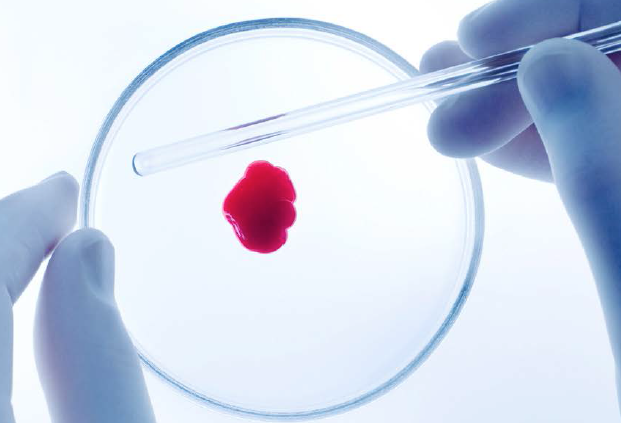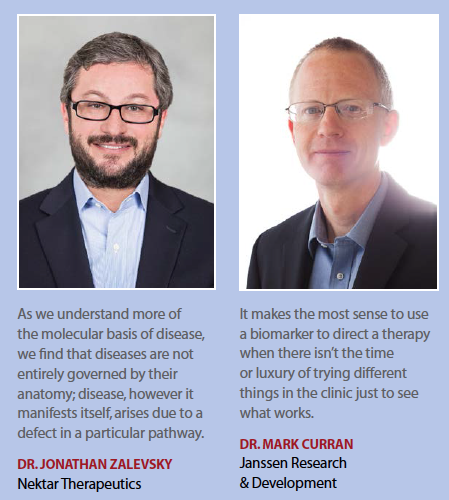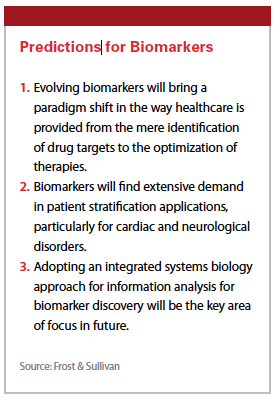 Biomarkers are becoming an essential part of the drug discovery and development process. A biomarker-driven approach to developing targeted therapies and patient selection strategies has the potential to increase success in the drug development process, decrease costs, and ultimately improve patient outcomes.
Biomarkers are becoming an essential part of the drug discovery and development process. A biomarker-driven approach to developing targeted therapies and patient selection strategies has the potential to increase success in the drug development process, decrease costs, and ultimately improve patient outcomes.
The Tufts Center for the Study of Drug Development estimates the cost of developing a new drug at $2.6 billion and suggests that the costs of drug development are rising at a compound annual growth rate of 8.5%.
Additionally, pharmaceutical R&D is moving away from broad-spectrum therapies and toward targeted therapies for treating patients with subtypes of diseases as technologies become more sophisticated.
Technology is fundamentally changing the way that clinical trials are operationalized, says Rick Morrison, CEO of Comprehend.
“The excitement around biomarkers is that there are now technology infrastructures that allow researchers to do things that were not previously possible," he says.
Mr. Morrison points out that modern technology, often cloud-based technologies are purpose-built to scale to manage intense amounts of data or analysis in ways that were not previously possible before.
The global biomarkers market was valued at $24.10 billion in 2015, according to an analysis by MarketsandMarkets, and is expected to grow at a CAGR of 13.58% to reach $45.55 billion by 2020.
Increasing healthcare and R&D expenditures are the key growth drivers in this market. Diagnostics development accounted for the largest share of the global biomarkers market in 2015.
Experts say oncology is the fastest-growing area for the use of biomarkers. In fact, the global cancer biomarkers market, which has experienced substantial growth over the last couple of years, is expected to grow at a CAGR of 11.6% from 2015 to 2020, according to a recent report from MarketsandMarkets.
 Factors such as rising incidence of cancer; technological advancements in “omics" technologies; favorable government funding for cancer research; increased demand for personalized medicines in cancer therapies; and increased use of biomarkers in drug discovery development and clinical trials are expected to fuel the growth of the cancer biomarkers market during the forecast period.
Factors such as rising incidence of cancer; technological advancements in “omics" technologies; favorable government funding for cancer research; increased demand for personalized medicines in cancer therapies; and increased use of biomarkers in drug discovery development and clinical trials are expected to fuel the growth of the cancer biomarkers market during the forecast period.
Cancer biomarkers are molecules secreted by a tumor or a specific response of the body to the presence of cancer and enhance cancer detection and facilitate high-speed noninvasive diagnosis using genomics and proteomics tools.
“Biomarkers can help better identify patients who will respond to a therapy," says Rachel Laing, Ph.D., manager of Bionest Partners. “And an increased understanding of disease, as well technology advancements, are creating opportunities in the biomarker space.
“We’ve come a long way in the past five or 10 years to really understanding how disease pathways interact with each other," she continues. “And we now have more knowledge and more opportunities for biomarkers, with next-gen sequencing and new platforms."
There have been a number of successes in the biomarker area, says Brett Villagrand, senior director product solutions at Oracle Health Sciences.
“Not only has there been a benefit for patients but there has been a benefit to companies," he says. “One of the major goals of organizations is to bring a product to market quicker. By being able to incorporate analytics data into their clinical trial programs companies have been able to realize that they can get products to market faster."
This scalability is allowing researchers and companies to view patients in a much more targeted way.
 “There is a push to make treatments more personalized and look at the patient as an individual who has specific traits, which could help with the selection of an optimal treatment approach," says Orestis Mavroudis-Chocholis, Ph.D., principal business insights analyst, oncology, Decision Resources. “The best way to do this is to look for genetic biomarkers or proteins that are overexpressed in a particular tumor."
“There is a push to make treatments more personalized and look at the patient as an individual who has specific traits, which could help with the selection of an optimal treatment approach," says Orestis Mavroudis-Chocholis, Ph.D., principal business insights analyst, oncology, Decision Resources. “The best way to do this is to look for genetic biomarkers or proteins that are overexpressed in a particular tumor."
Dr. Mavroudis-Chocholis says this approach indicates that the use of biomarkers in drug development will increase, especially in oncology.
“Biomarkers are here to stay," he says. “All of the oncologists and payers I’ve spoken to agree that personalized treatment using biomarkers is the future in oncology."
Dr. Laing explains further that biomarkers can help better identify patients who will respond to a therapy.
“As we’ve seen in oncology, biomarkers can help to streamline the development process and identify specific patient populations," she says. “Recently, we’ve seen this in terms of immuno-oncology but it could be applicable to other indications."
Dr. Laing says having a biomarker is a way for companies to differentiate themselves, especially in the immuno-oncology world, which is crowded with many companies going after the same targets and indications.
In the future, medical use of biomarkers will allow us to treat different diseases by specific pathway-targeting drugs, says Jonathan Zalevsky, Ph.D., VP, biology and preclinical development at Nektar Therapeutics.
“As we understand more and more about the molecular basis of disease we find that diseases are really not entirely governed by anatomy; disease, however manifested, arises due to a defect in a particular pathway," he says. “The choice of medicine that a patient will receive can be specifically pathway dependent."
Dr. Zalevsky says because of this understanding, in the future biomarkers will represent a greater component of modern medicine.
“Today, and in the next era of drug development, we will see greater personalization," he says. “We will see more and more personalized medicines that are designed for highly targeted, highly defined patient populations. This is going to have a very positive impact, both from the success of those medicines and ultimately on the economic benefit to our society."
A biomarker strategy can be a way for a company to differentiate its product and itself in a market, Dr. Laing says, adding it becomes important for a new product to have a biomarker in many indications because it provides physicians (and patients) with a greater sense of certainty that the product will work in the specific patient population versus a broader patient population, with an uncertain or low response rate.
Biomarkers’ Impact on R&D
 There are several ways that biomarkers are being used in drug development. They can be used to indicate whether a drug being developed is likely to be efficacious in treating a disease or to assess the safety of a treatment. Biomarkers also have an important place in diagnostics to help identify subclasses of patients who have a particular disease or who may be either particularly responsive to a specific therapy or drug being developed or particularly unresponsive.
There are several ways that biomarkers are being used in drug development. They can be used to indicate whether a drug being developed is likely to be efficacious in treating a disease or to assess the safety of a treatment. Biomarkers also have an important place in diagnostics to help identify subclasses of patients who have a particular disease or who may be either particularly responsive to a specific therapy or drug being developed or particularly unresponsive.
Biomarkers can guide patient selection for clinical trials, as well as identify adverse events. Efficacy biomarkers as surrogate endpoints in clinical trials enable companies to cut time needed for studies in therapeutic areas where standard trial endpoints take years to assess. Biomarker systems also enable companies to halt unsuccessful trials earlier.
“Biomarkers can help us determine which patients are more likely to respond to a particular drug class and to identify which subset of patients with a particular disease could be highly responsive to the drug being developed," says Mario Rocci, Ph.D., senior VP of laboratory services at ICON.
“This information allows us to focus much better on that patient population, making the drug development process more efficient and less costly."
In fact, the Food and Drug Administration estimates that just a 10% improvement in the ability to predict drug failures before clinical trials could save $100 million in development costs per drug. Biomarkers also offer the potential to inform treatment decisions and to bring personalized medicine into clinical practice.
The use of biomarkers is a part of the FDA’s Critical Path Opportunities List. The Critical Path Initiative is the FDA’s strategy to drive innovation in the scientific processes through which medical products are developed, evaluated, and manufactured.
The initiative was launched in 2004, and it lists 76 tangible examples where new scientific discoveries — in fields such as genomics, imaging, and informatics — could be applied during development to improve the accuracy of tests that predict the safety and efficacy of potential products.
Because biomarkers can predict drug efficacy more quickly than conventional clinical endpoints, they hold the potential to substantially accelerate product development in certain disease areas.
 Dr. Mavroudis-Chocholis says a key advantage of having a drug associated with a biomarker is that the medication can be given to those patients who are most likely to respond.
Dr. Mavroudis-Chocholis says a key advantage of having a drug associated with a biomarker is that the medication can be given to those patients who are most likely to respond.
“Companies are keen to develop these biomarkers and produce drugs that are very efficacious even if they are for very small, niche patient populations," he says. “In addition, companies can use the fact that the drug has a biomarker for more favorable reimbursement consideration."
Suso Platero, Ph.D., senior director, translational research oncology, at Janssen Research & Development, says biomarkers have the added potential to speed up drug development.
“By using biomarkers in Phase I, we can rapidly find the right dose for the compound and assure the right mechanism of action," he says. “Also if the right predictive biomarker is identified in Phase I of clinical development, we can go directly to a registration trial, thus eliminating a whole phase of development. In several development programs, we have identified markers that are able to predict which patients will benefit from our compounds. We are now applying those markers to registration trials and developing the companion diagnostic simultaneously."
All of Janssen’s research programs have a biomarker strategy. Even before a program moves out of the preclinical space and becomes considered for human studies, Janssen researchers are already generating the biomarkers that they will use in the clinic, says Mark Curran, Ph.D., VP, systems pharmacology and biomarkers, immunology therapeutic area, at Janssen Research & Development.
“We’re always looking at the potential to identify predictive markers or stratification markers to help target the new therapies and, for some of the old ones, to better target them to patients who will have a better outcome," he says.
Specifically, within immunology, the company has a high commitment to using biomarker tools to guide decisions and, ultimately, make treatments more effective. The company has had success using specific measurements to understand what a product’s dose needs to be and what biologic effect the therapy is having.
Dr. Curran says to accomplish these goals, the company uses specific assays directed at targets and specific types of activities, for example, phosphorylation assays or receptor occupancy assays, as well as transcriptomics and proteomics.
In the personalized medicine space, Janssen has several partnerships. One in particular is with U-BIOPRED (Unbiased BIOmarkers in PREDiction of respiratory disease outcomes), a group in Europe that aims to understand more about severe asthma.
 “This effort is directed at understanding asthma and understanding different patient groups and patient segments that may or may not respond well to certain types of interventions or drug treatments," Dr. Curran says. “We’re also trying to understand at the basic level the disease heterogeneity and how many different versions of asthma there are."
“This effort is directed at understanding asthma and understanding different patient groups and patient segments that may or may not respond well to certain types of interventions or drug treatments," Dr. Curran says. “We’re also trying to understand at the basic level the disease heterogeneity and how many different versions of asthma there are."
Janssen was conducting a trial called ADEPT, which aimed to correlate clinical features and biomarkers with molecular characteristics, by profiling asthma.
U-BIOPRED was conducting a similar study. The two formed a private-public collaboration to compare data sets. A manuscript with the results has been accepted for publication.
Another Janssen program is in ulcerative colitis. The company is investigating the possibility of identifying a predictive biomarker for response to a specific anti-TNF. Dr. Curran says the company is now completing that study.
“We’re not in a position yet where we can say what the results are because we’re crunching the data, but it’s an example where Janssen has invested heavily to run a clinical trial specifically to identify and validate a predictive biomarker for the anti-TNF class," he says.
Dr. Curran says the company is also making an investment in research of biomarkers for launched assets and established classes to better understand not only the next drug in the pipeline, but to understand what current therapies do and how Janssen can holistically improve the entire scope of patient care.
“It makes the most sense to use a biomarker to direct a therapy when there isn’t the time or luxury to try different things in the clinic just to see what works," he says. “For example, in the oncology space, it’s incredibly important to get the therapy right as soon as possible. In immunology, we’re focused on inflammatory bowel disease, RA, and psoriasis. These are disorders where the longer the patient suffers from the disease, the more systems are affected and the worse the outcomes are going to be."
Nektar Therapeutics is another company that is putting greater emphasis on biomarkers as part of its development strategy. The company is using biomarkers to track activity and pharmacodynamics of drugs as well as to study disease and treatment pathways.
Two of the company’s products in clinical development both have biomarker programs associated with them. One of these is NKTR-181, which is an opioid analgesic in Phase III trials. The other is NKTR-214, which is an immune-targeting therapy that just entered its first clinical testing in patients.
“We have one set of markers that are pharmacodynamically linked to the drug, and then we have a robust set of markers that are linked to personalization," Dr. Zalevsky. “These include markers of the underlying mutagenicity of the tumor and the relationship of the tumor’s mutagenicity to the strength of a person’s immune activation."
On the immune system side, the company is studying an important biomarker, a T-cell repertoire that the immune system mobilizes against in a particular tumor type.
“We believe that if we can improve the T-cell specificity and improve its reactivity we’ll be able to mobilize a more robust anti-tumor response," Dr. Zalevsky says. “We’re also doing biomarker measurements by studying those T-cell populations and their specificity."
Limitations of the Biomarker Approach
Frost & Sullivan researchers say the complex nature of resource-driven biomarker validation studies delays the process of finding results.
Large-scale validation studies of candidates also pose considerable logistical and regulatory challenges. These are expected to reduce once best practices for analytic validation of various analytes/platforms are developed and more standardized regulatory protocols and parameters for assay validation are introduced.
Dr. Mavroudis-Chocholis says a key challenge to using biomarkers in research is the actual identification of the biomarkers themselves, which requires a lot investment in preclinical and clinical studies.
“This requires time and patients to be enrolled in clinical trials and then using those results to inform the best possible Phase III prospective trials, which can then be used to facilitate a global approval," he says.
Dr. Rocci agrees that finding the right biomarker in and of itself is a huge challenge.
“There can be multiple bodily systems that can change with a particular disease, but not all may be intimately tied to the primary pathophysiology of the disease," he says. “There could be secondary or tertiary effects. So if the focus is on the wrong biomarker, research could be led astray."
Dr. Rocci also points out the ability to easily analyze the biomarker is another challenge.
“We’d like to know whether the biomarkers are actually stable in blood or urine samples under appropriate sample storage conditions, and this can be a challenge," he says. “This requires quite a bit of upfront work to ensure that measurements are valid because we could run the risk of erroneously measuring the integrity of our samples during a clinical trial as opposed to the effect our drug has on the disease."
Dr. Platero says there are two additional challenges: the internal acceptance of the data and the operational execution of the plan.
“For internal acceptance, we need to do a better job presenting our ideas and bringing the team on board, keeping them in the pursuit of data especially when trials take so long to complete," he says. “To enhance our execution, we have created a new group in our department that greatly aids our processes and makes sure things keep moving."
Dr. Platero says good communication with internal and external teams and a clear definition of roles and responsibilities is a must to make sure this process moves rapidly and efficiently.
Dr. Laing says if the goal is to develop a companion diagnostic then all of the developmental processes to validate the test have to be done at the same time as the drug development.
“There was a period of time when these two approaches were not perfectly aligned; there have been a few cases when the biomarker was discovered after the drug was approved, which required additional development to catch up," she says. “Companies now are realizing that this decision should be made earlier so that they can time the development appropriately."
Industry experts also point to the challenges of managing the vast amounts of data that are often generated through biomarker strategies.
“There is a lot of data that’s being generated via disparate sources or reside in different silos or information systems," Mr. Villagrand says. “The challenge for a number of companies is how to combine the data to be included in the clinical trial, as well as to integrate that into the system. Many of the challenges companies face are around the aggregation, collection, and the interpretation of the data and how that information be implemented into the clinical trial."
Biomarkers can add value as well as complexity to drug development, Dr. Zalevsky says. It’s important to show that the biomarker is valid and that it can be validated in terms of the human biology.
“Then we have to show that it’s meaningful for the medicine," he says. “For example, we have to do a set of studies in both biomarker positive and biomarker negative patients to truly demonstrate the medical benefit of the biomarker."
Frost & Sullivan researchers say diagnostic developers and pharmaceutical companies could enter partnerships and strike licensing deals to reduce drug development costs and prevent late-stage failures that are especially common when it comes to cancer. Not only will these strategic collaborations enable the quick commercialization of drugs, it will also help bring in theranostic platforms to monitor drug responses. (PV)


















